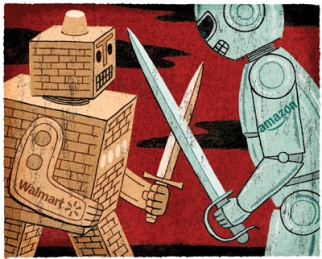 5年前,世界上最大的零售连锁超市根本不会在乎世界上最大的网上购物中心。根据研究员Kantar Retail提供的数据,沃尔玛的顾客中,只有1/4的人会在亚马逊购物。但是,今天,大约有将近一半的沃尔玛客户都表示会光顾亚马逊。这就让这个曾是全美最为厉害的零售商,不能再对这个网上对手置之不理了。
5年前,世界上最大的零售连锁超市根本不会在乎世界上最大的网上购物中心。根据研究员Kantar Retail提供的数据,沃尔玛的顾客中,只有1/4的人会在亚马逊购物。但是,今天,大约有将近一半的沃尔玛客户都表示会光顾亚马逊。这就让这个曾是全美最为厉害的零售商,不能再对这个网上对手置之不理了。
对沃尔玛的垄断地位构成威胁的主要是两方面的因素:一个是折扣卖场的老顾客——这些偏爱折扣的消费人群一年大概有5万美元的收入,他们变得越来越知晓现代科技:另一个就是大萧条时期经常光顾沃尔玛的顾客,现在他们的经济状况改善了,转而去亚马逊消费了。亚马逊经营的商品种类已经开始向沃尔玛靠拢,从尿布到真空吸尘器的包装袋。在上一财年,亚马逊的收入增长了41%,达到了481亿美元,而沃尔玛只有8%的增长。Kantar表示,沃尔玛在2011年网上运营收入只占总收入2640亿美元的2%。来自美国硅谷沃尔玛专案小组的首席技术负责人Jeremy King称,沃尔玛一直都在注意着亚马逊的动态。
去年,沃尔玛已经增加了网上业务的投资。自从去年5月份,沃尔玛花3亿美元,受够了5家科技公司,并在美国和印度雇佣了至少300名工程师和编码人员。沃尔玛正在推出一个方案:允许20%的沃尔玛顾客即使在没有信用卡和银行账户的情况下,可以在网上购物。
沃尔玛的并购包括Kosmix,一家社会传媒公司;以及iPhone app的发明者 Small Society。沃尔玛是希望这些公司能够想办法不让顾客扫描商品,然后一走了之。许多顾客都用手机在超市扫描商品的条形码,然后到沃尔玛的对手公司去网上购物。沃尔玛的技术小组正在研究一个Endless Aisle的技术,这个新法子让顾客只要用手机扫描,就会从沃尔玛的网上商店购买该商品,即使是在这个产品已经脱销的情况下。沃尔玛全球电子商务副总裁Venky Harinarayan表示,因为沃尔玛不能要求顾客将手机寄存在超市门口,所以,必须要给他们一些提示。
沃尔玛正在加强库房,网站可手机应用程序之间的联系,这样就会有越来越多的顾客能够从网上订购商品,然后再实体店中取货,其实已经有近一半的网上客户开始这样做了。沃尔玛正在努力尝试与互联网为基础的销售模式,例如它的支付现金功能就是为了让那些没有信用卡的人也可以购物。这个新出台的办法能够让顾客把东西先存到网上,然后就近付款。为了满足高水平消费者的需求,沃尔玛开始售卖一些比较贵的东西,比如索尼和三星的高端电视,当然,这只限于网上。
Harinarayan的小组正在为沃尔玛解决一个新的问题。去年沃尔玛的首要目标顾客是节假日消费者,大概有53%的美国人会在节假日期间光临沃尔玛。这已经比前年的59%下降了。为了吸引这些消费者,技术专家们开发了一个Shopycat的特写,这个特写可以扫描顾客在Facebook上的朋友的社会圈子,进而为顾客提供沃尔玛网上可以订购的礼物。大约有15万用户已经安装了这个程序。
为了不断推出这些新奇的想法,沃尔玛必须要不断改善内部电子商务的技术,所以King才会一下子雇用了87位工程师和编码人员。EBay的一位老将表示,我们这在从零开始,以求建立良好基础。其实,最理想的局面是我们在几年前就应该建立这样的一个平台。
 Five years ago, the world’s largest retail chain didn’t have to worry much about the world’s largest online mall. Only about a quarter of Wal-Mart Stores (WMT) customers shopped at Amazon.com (AMZN), according to data from researcher Kantar Retail. Today, however, half of Wal-Mart customers say they’ve shopped at both merchants. That’s leaving the mega-retailer—which long ago bested local brick-and-mortar merchandise stores and supermarkets across America—with a massive online competitor that is too tough to ignore.
Five years ago, the world’s largest retail chain didn’t have to worry much about the world’s largest online mall. Only about a quarter of Wal-Mart Stores (WMT) customers shopped at Amazon.com (AMZN), according to data from researcher Kantar Retail. Today, however, half of Wal-Mart customers say they’ve shopped at both merchants. That’s leaving the mega-retailer—which long ago bested local brick-and-mortar merchandise stores and supermarkets across America—with a massive online competitor that is too tough to ignore.
Threatening Wal-Mart’s dominance are two trends: The discounter’s traditional customers—bargain hunters making less than $50,000 a year—are getting more tech-savvy, and more-affluent shoppers who began frequenting Wal-Mart during the recession are returning to Amazon as their finances improve. Amazon has moved into merchandise categories that Wal-Mart traditionally has sold, from diapers to vacuum cleaner bags. In its last fiscal year, Amazon posted 41 percent revenue growth, to $48.1 billion, vs. 8 percent at Wal-Mart. The chain’s 2011 online sales amounted to less than 2 percent of its $264 billion in U.S. revenue, says Kantar. “Amazon is always in our sights,” says Jeremy King, chief technology officer at the retailer’s @ WalmartLabs skunkworks in Silicon Valley. “My biggest issue is playing a catch-up game.”
In the last year Wal-Mart has increased its investment in its online business. The company has spent more than $300 million acquiring five tech firms since May and hired more than 300 engineers and code writers in the U.S. and India. Wal-Mart is also launching a program to allow the 20 percent of its customers without credit cards or bank accounts to make online purchases.
Wal-Mart’s acquisitions include Kosmix, a social-media firm, and iPhone app creator Small Society. The company hopes the newcomers can find a way to stop shoppers from engaging in scan and scram. That’s when would-be customers use their smartphones in stores to scan an item’s bar code and then buy it online from a rival merchant. The chain’s tech team also is working on a concept called Endless Aisle, which would let shoppers immediately order from Walmart.com via smartphone if an item is out of stock. “You can’t ask people to leave their phones at the door. So you have to give them value and an experience,” says Venky Harinarayan, @WalmartLabs’ senior vice president of global e- commerce. The former Amazon executive joined from Kosmix.
Wal-Mart is trying to improve links between its store inventory, website, and mobile phone apps so that more customers can order online and pick up their purchases at stores, which half of Web customers do already. Wal-Mart is trying Web-based shopping tactics, like its Pay With Cash program for Wal-Mart customers who don’t have credit cards. The new program allows them to reserve products online and pay cash at their nearest store. To cater to its affluent customers, Wal-Mart is selling more expensive items—for example, high-end televisions from Sony (SNE) and Samsung—only online.
Harinarayan’s team is also trying to tackle a new problem for Wal-Mart. Last year the chain was the No. 1 destination for holiday shoppers, with 53 percent of U.S. customers visiting its stores. That was down from 59 percent the year before. To lure gift shoppers, the techies have developed a Shopycat feature that scans the social media preferences of a consumer’s Facebook friends and suggests gift ideas sold on Walmart.com. About 150,000 users have installed the app.
To roll out more such innovations, Wal-Mart must improve its in-house e-commerce technology, so King will hire 87 engineers and coders to bolster the links between the stores and the website. “We’re starting from scratch to build a foundation,” says the EBay (EBAY) veteran. “Ideally, we’d have this platform built a couple of years ago.”
 5年前,世界上最大的零售连锁超市根本不会在乎世界上最大的网上购物中心。根据研究员Kantar Retail提供的数据,沃尔玛的顾客中,只有1/4的人会在亚马逊购物。但是,今天,大约有将近一半的沃尔玛客户都表示会光顾亚马逊。这就让这个曾是全美最为厉害的零售商,不能再对这个网上对手置之不理了。
5年前,世界上最大的零售连锁超市根本不会在乎世界上最大的网上购物中心。根据研究员Kantar Retail提供的数据,沃尔玛的顾客中,只有1/4的人会在亚马逊购物。但是,今天,大约有将近一半的沃尔玛客户都表示会光顾亚马逊。这就让这个曾是全美最为厉害的零售商,不能再对这个网上对手置之不理了。

 Five years ago, the world’s largest retail chain didn’t have to worry much about the world’s largest online mall. Only about a quarter of Wal-Mart Stores (WMT) customers shopped at Amazon.com (AMZN), according to data from researcher Kantar Retail. Today, however, half of Wal-Mart customers say they’ve shopped at both merchants. That’s leaving the mega-retailer—which long ago bested local brick-and-mortar merchandise stores and supermarkets across America—with a massive online competitor that is too tough to ignore.
Five years ago, the world’s largest retail chain didn’t have to worry much about the world’s largest online mall. Only about a quarter of Wal-Mart Stores (WMT) customers shopped at Amazon.com (AMZN), according to data from researcher Kantar Retail. Today, however, half of Wal-Mart customers say they’ve shopped at both merchants. That’s leaving the mega-retailer—which long ago bested local brick-and-mortar merchandise stores and supermarkets across America—with a massive online competitor that is too tough to ignore.